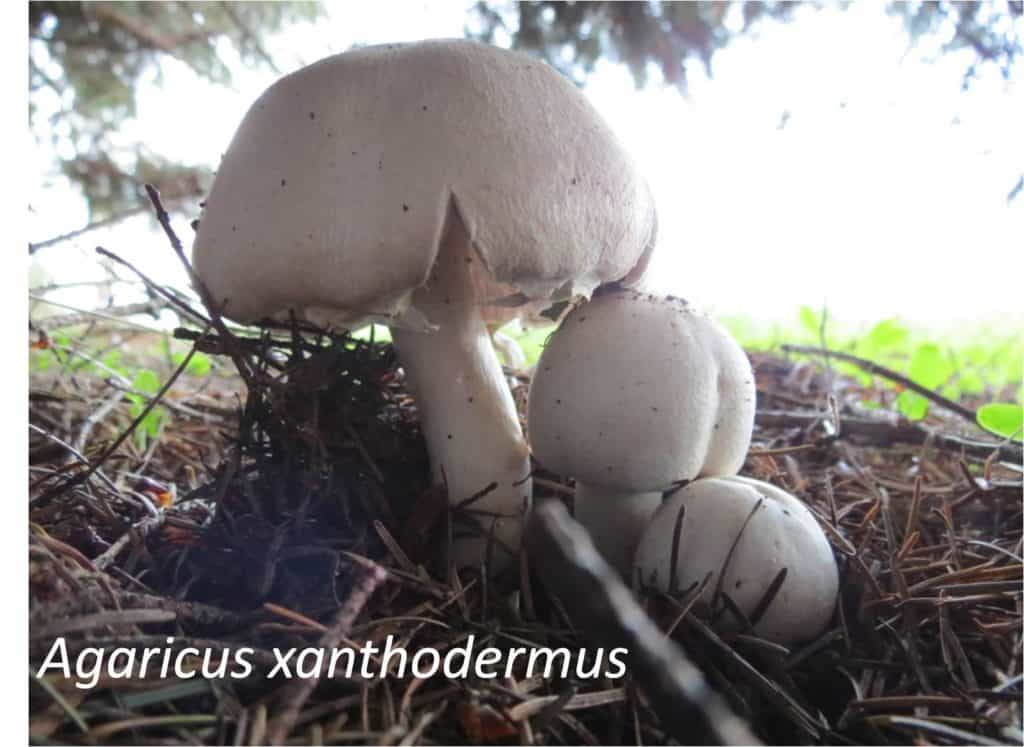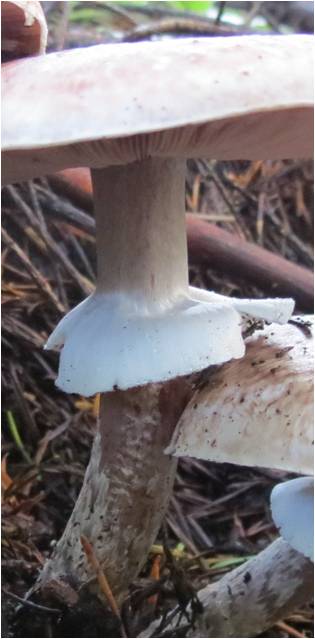Agaricus subrutilescens

Step away from the grocery store and try the woods. How many times have you gone to your local grocery store and debated over purchasing the white, crimini, or portobello mushroom? When I was a kid and went grocery shopping with my Mom they only had the white button mushroom, which they called the champignon mushroom. You really need to say the word “champignon” with a French accent to really make it sound classy and special. Oddly enough, the addition of the crimini and Portobello didn’t really add new mushroom choices, only mushroom variations. All three forms or styles are the exact same mushroom known as Agaricus bisporus. Although the grocery store did not add new mushrooms species, they did take the guesswork out of knowing if bisporus is an edible Agaricus species or one to avoid.
Now it’s time to step out of that grocery store safety zone and try your hand at finding and correctly identifying a wild species of edible Agaricus known as Agaricus subrutilescens or more commonly referred to as the wine-colored Agaricus. This may seem easier than it actually is since there are quite a few similar looking mushrooms out there and not all of them are edible.

The most common Agaricus species in our area is Agaricus xanthodermus or more commonly called the “yellow stainer” as its flesh stains yellow when scratched. It is one of several Agaricus species that David Arora referred to as the ”lose your lunch bunch”. Now don’t panic, once you know how to correctly key out the right species you can confidently quote Obi-Wan Kenobi and say “those are not the Agaricus mushrooms we are looking for”. Besides, I have only been seeing the yellow stainer in urban/suburban areas and not in the woods.

So, here is the checklist for identifying this quite attractive and stately wine-colored Agaricus. First, this is a forest dweller and I have found it from the coast to the Cascade Mountains and many forested places in between. If moisture levels are adequate, it can be found in late summer and continuing into late fall. I actually find it more now than in past years. To start with, only deal with samples that are in good condition and make certain they display all the required characteristics in the checklist. The underlying cap color can be cream colored or off-white; however, it will be either partially or completely covered by dull wine red to brownish fibrillose scales giving it the appearance of having a patchwork design on its cap. This attribute is a very important distinction from other Agaricus species and can be easily seen from a distance.

The stem or stipe, as some refer to it, is also a very important feature to note. If you check the point at which the cap connects to the stem, you’ll see that the caps gills approach the stem but are not directly attached to it. Textbooks define this gill/stem relationship as being “Free”. Additionally, the area between the underside of the cap and the stem’s ring (or annulus) will be mostly smooth while the section below the ring will be covered with shaggy scales, giving it a rough texture. You also want to make certain the stem’s ring is present as it can drop off in rough weather or simply fall off as it ages (kind of like what happened to my hair). The gills of this species as with other Agaricus species start out white when young, transition to pink, and finally to a chocolate brown at maturity (the opposite of what happened to my hair). Now it’s time for the color change and odor.

Some species of Agaricus will stain yellow when bruised or cut like Agaricus xanthodermus and others can stain red like Agaricus bernardii. According to David Arora’s book, the Agaricus subrutilescens color key states that “Flesh not reddening or yellowing when cut and rubbed repeatedly”; however, in Mushrooms of the Redwood Coast, it states that “gills sometimes becoming red or darker pink where injured”. In any event, there is not a dramatic change of color for this species. As for odor, it has a mild aroma, unlike other species which can smell like library paste or have a chemical type of odor. At the same time, others like Agaricus augustus smells like almonds or maraschino cherries. Finally, if you take the time to place the cap on a white sheet of paper to do a spore print, you will note the dark chocolate brown color of its spores. This genus of mushrooms make great artistic looking spore prints and doing so adds to the mushroom validation process.
If the mushroom you have found passes all these key requirements you have most likely discovered Agaricus subrutilescens. If you have any doubt or if you plan to eat this mushroom please consult one of our expert CMS mushroom identifiers. Even after confirmation of your find, you’ll want to fully cook this mushroom and only try a small amount the first time you try it. While this mushroom is considered a good edible, some people have had an allergic reaction to it. Always set aside some of your mushrooms in a brown paper bag and keep it in the refrigerator in the event you do have a reaction to it. We never want anyone to have a bad experience and we always opt for the health and safety of our fellow mushroom enthusiasts. And it also goes without saying, although I am saying it anyway; Never harvest mushrooms near busy roadways, coal sludge dump sites, old uranium minds, or spots previously used as a meth lab.
Photo credits:
All photos were taken by Ron & Sandy with the exception of “Portobello, crimini, and button types of Agaricus bisporus” image credit: Tom Volk, University of Wisconsin. Taken from LocalWiki
References:
Steve Trudel & Joe Ammirati, Mushrooms of the Pacific Northwest
David Arora, All That the Rain Promises and More
Noah Siegel & Christian Schwarz, Mushrooms of the Redwood Coast





